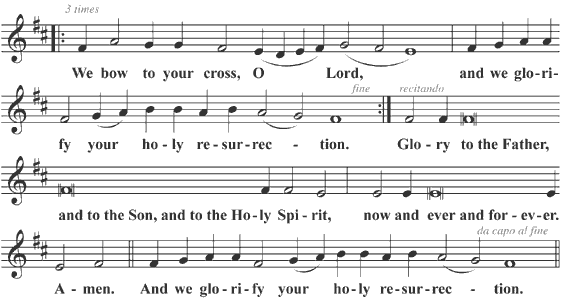Singing the Trisagion of the Divine Liturgy
The Trisagion ("Holy God"), also called the "Thrice-Holy Hymn", is the final hymn of the enarxis or entrance rites of the Divine Liturgy, and the high point of that part of the service. This article explains how to sing the Trisagion at the Divine Liturgy, as well as the hymns that replace it on certain occasions, and covers pages 27-33 of our Divine Liturgies book.
At this point in the service, we have completed the "three antiphons" that originally accompanied the people's procession through the streets of Constantinople to the church where the Liturgy would be held. The clergy have made the Small Entrance into the sanctuary with the Gospel book, and now we sing the Trisagion: the ancient processional hymn of the Byzantine Rite.
The Trisagion
The Divine Liturgies book provides six musical settings for the Trisagion, or "Holy God": five ordinary settings (A-E) and one specifically for Divine Liturgies for the dead (F). The cantor should choose which one is to be sung well in advance of the service, practice it, and be ready to sing it after the deacon's exclamation that follows the third antiphon.
Here is the A setting of the Trisagion:
As usual, make sure you can identify the key signature, find the tonic pitch or do, and identify the solfege syllables for the first three or four notes.
If necessary, you can select a new starting pitch for the Trisagion, since it is not closely tied to what came before it. The hymn should be sung broadly, neither too quickly nor too slowly, and each repetition of "Holy God, Holy and Mighty, Holy and Immortal, have mercy on us" should be sung as much as possible as if it were a single phrase rather than three separate phrases.
(If sung as three separate phrases, then it will sound like "have mercy on us" only goes with "Holy and Immortal", and the entire hymn will have 18 phrases or "parts." But if each repetition of "Holy God...." can be sung as a unit, then the congregation will "hear" three repetitions of Holy God, the doxology, the end of Holy God, and one more repetition; the entire hymn will have much better integrity and "flow.")
Here is the B setting of the Trisagion:
Notice that where the setting repeated the "Holy God" melody for the doxology ("Glory... now and ever..."), the B setting uses a simple recitative melody (mi - re, re - mi). The same considerations, though, apply as with the A version: try to sing each major part of the hymn as a unit, without a pause or noticeable break.
Here is the C setting of the Trisagion:
Always remember to start this setting fairly high, since it descends almost an octave from the starting pitch. It may be necessary to sing the doxology ("Glory... now and ever...") a bit faster to keep it from dragging.
Here is the D setting of the Trisagion:
The balance in the phrases here is a little different; since the first part of the doxology doesn't use the entire "Holy God" melody, but starts over from the beginning with "now and ever", a slight pause after "and to the Holy Spirit" is entirely appropriate.
Here is the E setting of the Trisagion, the last of the "ordinary" melodies. This beautiful setting will challenge your breathing, so don't begin it too slowly!
Finally, here is the F version of the Trisagion, "for the faithful departed". The first solfege syllable here is si (sol, raised by a half step).
The baptismal hymn: "All you who have been baptized into Christ"
This hymn replaces the Trisagion on days associated with baptism, as well as when baptism is celebrated within the Divine Liturgy. The Divine Liturgies book provides two musical settings.
Here is the A version, a traditional Rusyn (trans-Carpathian) setting:
Here is the B version, a festal Galician (western Ukrainian) setting:
The hymn for the Cross: "We bow to your cross, O Lord"
This hymn replaces the Trisagion on two days on which we venerate the holy Cross: the third Sunday of the Great Fast, and the feast of the Exaltation of the Cross (September14). By local custom, it may also be sung on post-festive days of the Exaltation of the Cross.
As with the baptismal hymn, there are two musical settings, one Rusyn and one Galician.
Here is the A version (Rusyn):
Here is the B version (Galician);

Once the singing of the Trisagion or its replacements is complete, the Divine Liturgy continues with the readings. See Singing the Readings of the Divine Liturgy.











